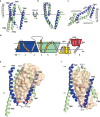Transport mechanism of a bacterial homologue of glutamate transporters
- PMID: 19924125
- PMCID: PMC2934767
- DOI: 10.1038/nature08616
Transport mechanism of a bacterial homologue of glutamate transporters
Abstract
Glutamate transporters are integral membrane proteins that catalyse a thermodynamically uphill uptake of the neurotransmitter glutamate from the synaptic cleft into the cytoplasm of glia and neuronal cells by harnessing the energy of pre-existing electrochemical gradients of ions. Crucial to the reaction is the conformational transition of the transporters between outward and inward facing states, in which the substrate binding sites are accessible from the extracellular space and the cytoplasm, respectively. Here we describe the crystal structure of a double cysteine mutant of a glutamate transporter homologue from Pyrococcus horikoshii, Glt(Ph), which is trapped in the inward facing state by cysteine crosslinking. Together with the previously determined crystal structures of Glt(Ph) in the outward facing state, the structure of the crosslinked mutant allows us to propose a molecular mechanism by which Glt(Ph) and, by analogy, mammalian glutamate transporters mediate sodium-coupled substrate uptake.
Figures





References
-
- Danbolt NC. Glutamate uptake. Prog Neurobiol. 2001;65:1–105. - PubMed
-
- Mitchell P. A general theory of membrane transport from studies of bacteria. Nature. 1957;180:134–6. - PubMed
-
- Patlak CS. Contributions to the theory of active transport: II. The gate type non-carrier mechanism and generalizations concerning tracer flow, efficiency, and measurement of energy expenditure. Bulletin of Mathematical Biology. 1957;19:209–235.
-
- Jardetzky O. Simple allosteric model for membrane pumps. Nature. 1966;211:969–70. - PubMed
Publication types
MeSH terms
Substances
Associated data
- Actions
Grants and funding
LinkOut - more resources
Full Text Sources
Other Literature Sources
Molecular Biology Databases

